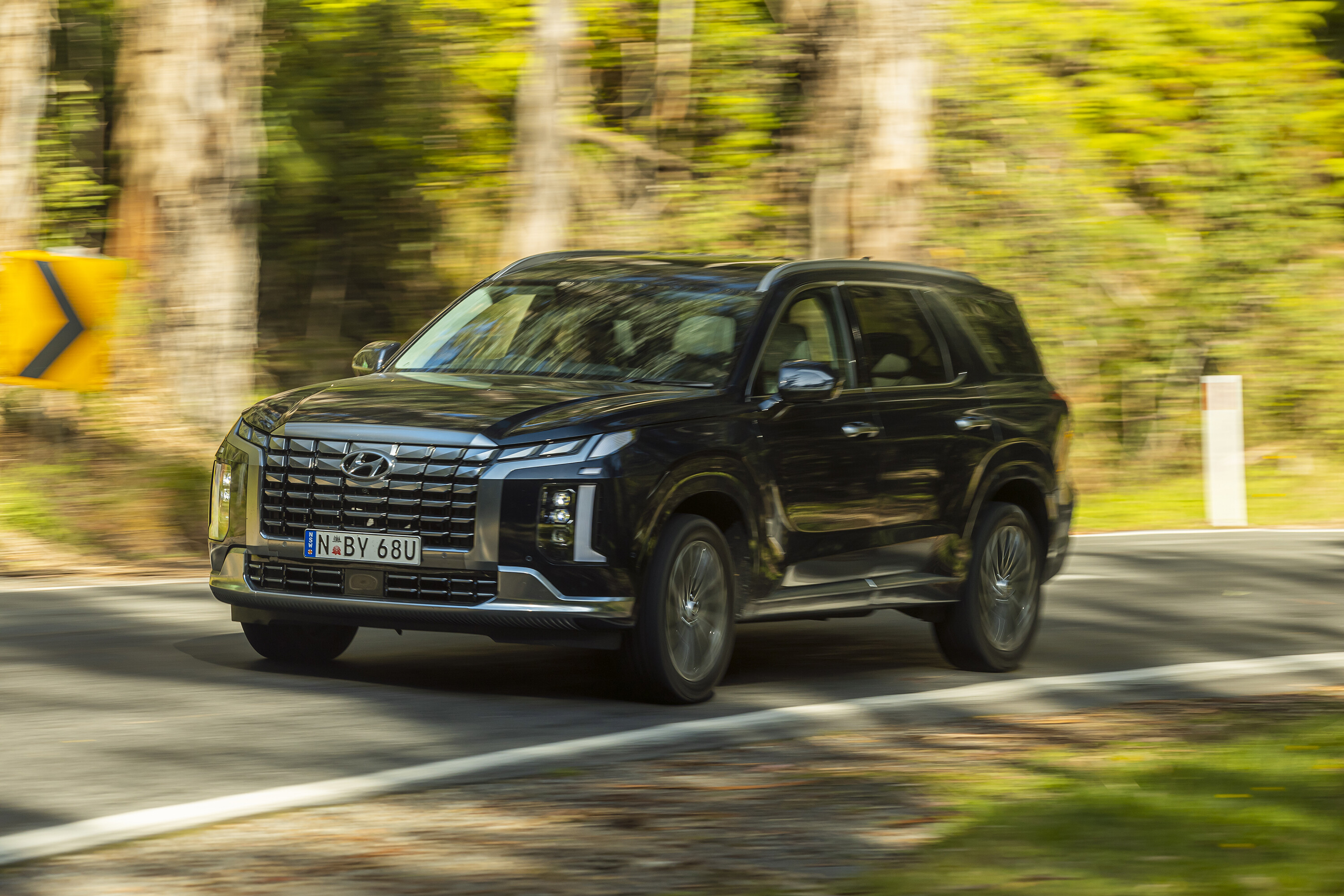
Score breakdown
Things we like
- Clever packaging and thoughtful touches
- Comfortable ride with solid road-holding
- Plenty of features for the money
Not so much
- Thirsty petrol V6
- Nannying speed limit assist
Australians love value from their motors. Not cheap cars, mind you, but rather those that deliver plenty of kit and space for a lot less than you might think.
Tony O’Kane compared this genre to the ‘McMansion’, and he wasn’t wrong. It’s also the secret to the Hyundai Palisade’s enduring success.
Initially knocked with a four-star ANCAP safety rating in its earlier guise, an update in August 2022 saw the Palisade score the must-have five stars, with improvements in technology and appearance along for the ride.
It didn’t change the Palisade’s value equation, though – the Palisade remains a stand-out player in the large seven- or eight-seat SUV category.

JUMP AHEAD
- Pricing
- What body styles are available for the Palisade?
- What features are standard in every Palisade?
- What key features do I get if I spend more?
- How safe is the Palisade?
- How comfortable & practical is the Palisade?
- How much boot space does the Palisade have?
- I like driving, will I enjoy this car?
- Which Palisade engine uses the least fuel?
- What is the Palisade’s towing capacity?
- How long is the warranty & what are the Palisade’s servicing costs?
- Which version of the Palisade does Wheels recommend?
- What are the Palisade’s key rivals?
- What might annoy me?
- What might I miss that similar cars have?
- What’s the infotainment system like?
- Where does Hyundai make the Palisade?
- Are there plans to update the Palisade soon?
Pricing
| 2023 Hyundai Palisade Model | Price |
|---|---|
| Elite 2WD | $65,900 |
| Elite AWD | $69,900 |
| Highlander 2WD | $75,900 |
| Highlander AWD | $79,900 |
| Prices listed are before on-road costs |
What body styles are available for the Hyundai Palisade?
The Hyundai Palisade is a five-door large SUV with seating for seven or eight occupants, depending on specification.

What features are standard in every Hyundai Palisade?
The features listed below are standard in the entry-level model and will appear in higher-grade models unless replaced by more premium equivalent features.
| 2023 Hyundai Palisade Elite features | |
|---|---|
| 10-way power driveru2019s seat adjustment | Driver talk function |
| 12 speaker Infinity audio system | Four-spoke leather steering wheel |
| 12.3-inch Instrument cluster | Hyundai Bluelink smartphone connectivity and telematics |
| 12.3-inch touchscreen display | LED headlights, tail-lights and daytime running lights |
| 15-watt wireless phone charging pad | Multi-Bluetooth connection |
| 16 cup holders | Quiet mode function |
| 20-inch alloy wheels | Single-panel sunroof |
| 4-way power passenger seat adjustment | Skid plates |
| 7x USB charging points | Speed adjustable, hands-free power tailgate |
| Auto-dimming rearview mirror | Tri-zone climate control |
| Black leather seats | Voice recognition |
| Black tinted grille | Wired Apple CarPlay and Android Auto |

What key features do I get if I spend more?
With only two Palisade variants now available the choice is pretty simple, and the up-spec Highlander justifies its $6000 premium with a stack more creature comforts and quilted upholstery. It feels ‘Range Rover lite’ – just what buyers in this segment want.
The ritzy Hyundai Palisade Highlander adds:
| 2023 Hyundai Palisade Highlander features | |
|---|---|
| Nappa leather seats (available in Warm Grey two-tone, Dark Khaki two-tone or Black monotone) | 12-way power driver’s seat with two-position memory, 8-way power passenger’s seat |
| Heated and ventilated front and second-row seats | Body-coloured cladding and bumpers |
| Highlander exclusive skid plates and chrome grille with hidden DRL | Suede-cloth roof lining |
| Head-up display (HUD) | Integrated rear sunshades blinds |
| Automatic defog | Four-spoke, two-tone leather heated steering wheel |
| Digital electro-chromatic mirror with full display | Remote smart parking assist |
| Rain-sensing wipers | Dual sunroof with tilt function |
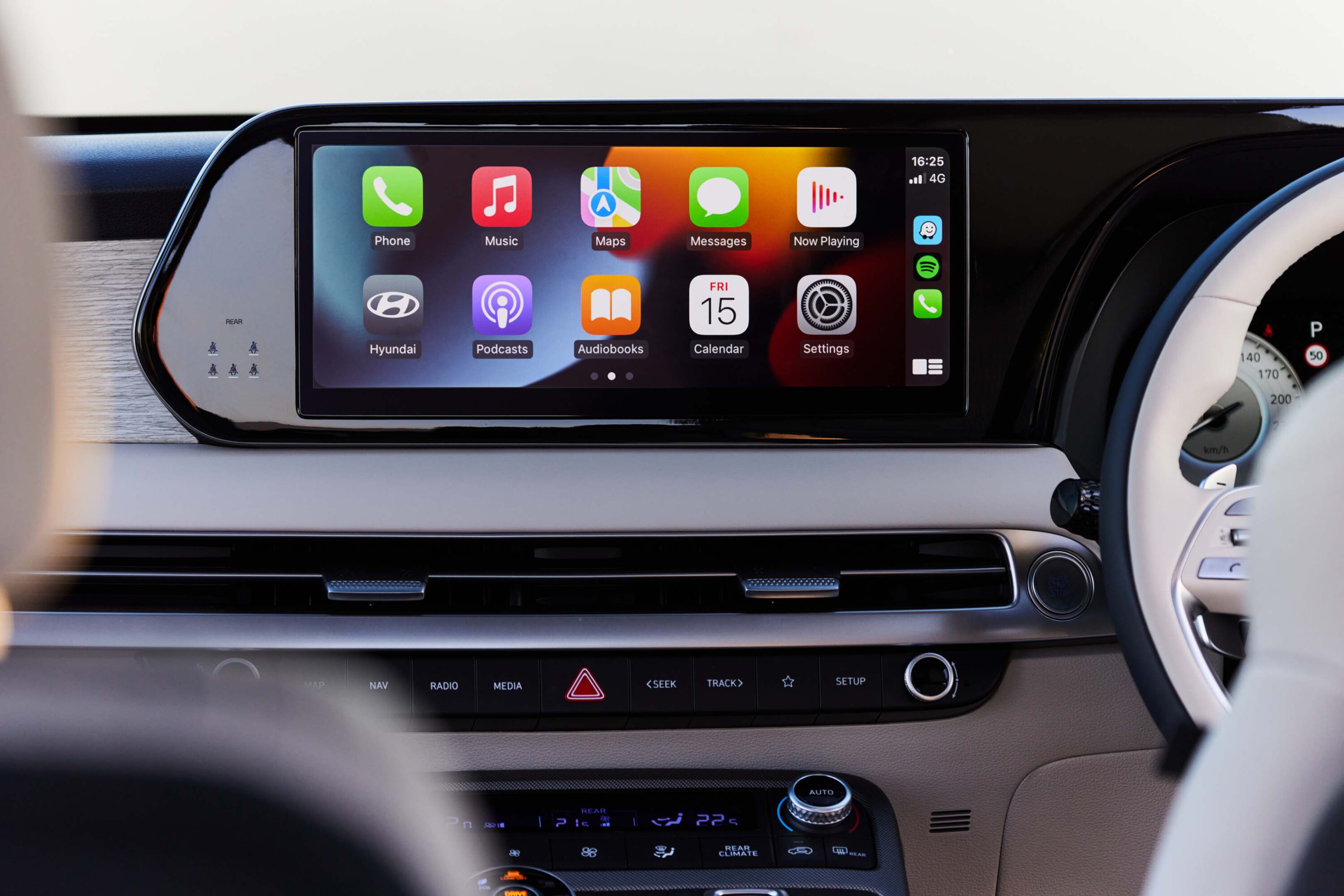
For no extra cost, you can specify both the Highlander and Elite with captain’s chairs in the second row, allowing easier ingress/egress to the three-wide back row.
How safe is the Hyundai Palisade?
Pre-facelift examples of the Hyundai Palisade were rated four stars by ANCAP, though a five-star ANCAP safety rating applies to models delivered from August 2022 onwards.
It was the mid-life introduction of a front centre airbag (that required significant reengineering and brought the Palisade’s total to eight) and improved radar-and-camera auto emergency braking (AEB) system that bolstered the Palisade’s safety credentials.
Further changes include an intelligent speed limit information system (that’s rather if nannying – sounding an alarm four times at just 1km/h over the limit) and multi-collision braking assist.
| 2023 Hyundai Palisade standard safety features | |
|---|---|
| Eight airbags | Multi-collision brake avoidance |
| Lane trace assist | Lane departure warning |
| AEB with day/night pedestrian, day cyclist detection and junction AEB | Traffic sign recognition with intelligent speed limit assist |
| Auto high beam | Adaptive cruise control with stop-and-go |
| Driver attention monitor | Safe exit assist |
In addition, the Highlander grabs a few nice-to-have features that help when manoeuvering this behemoth. These include a blind-spot view monitor in the digital driver’s display, a 360-degree surround-view monitor, and low-speed reverse AEB.
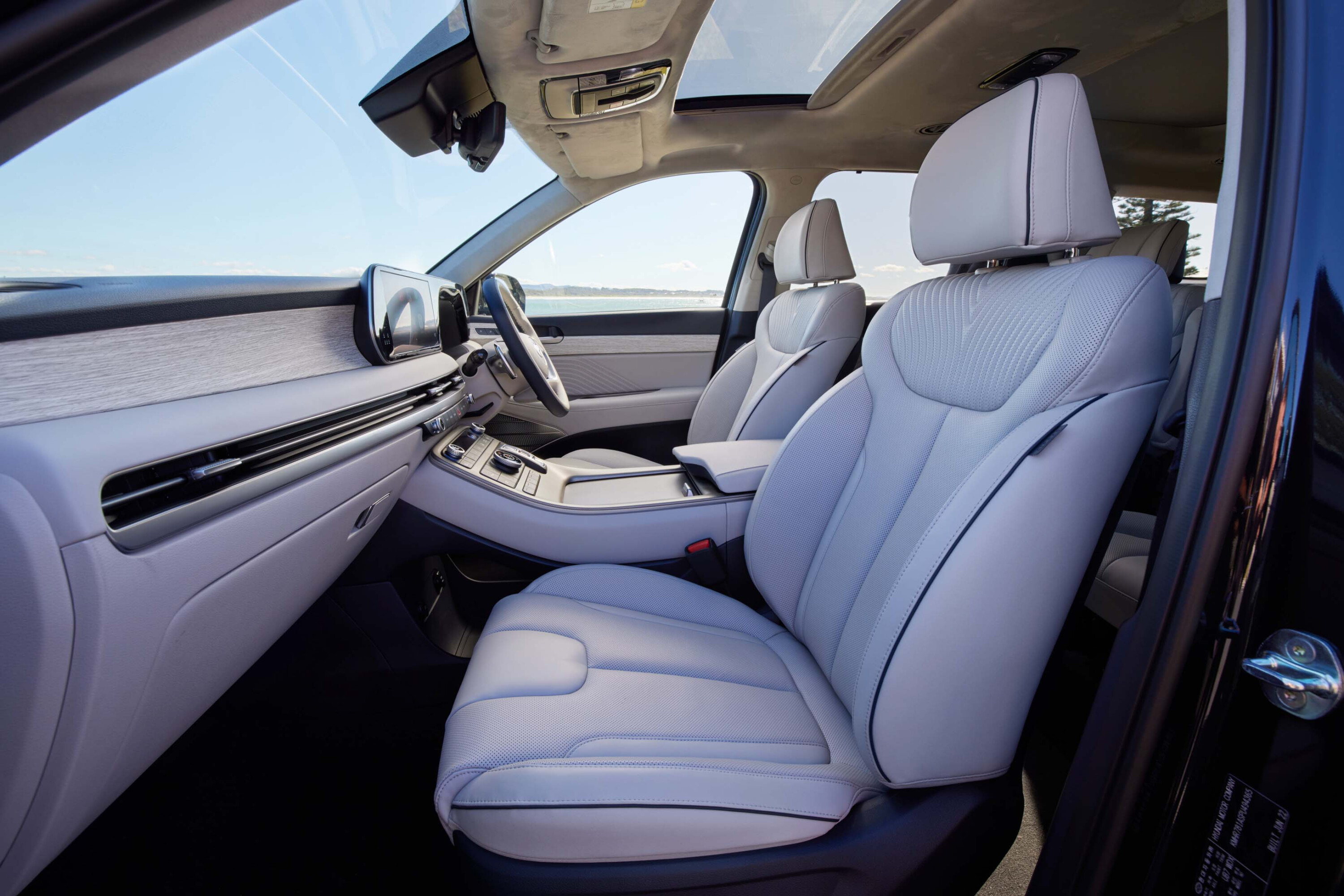
How comfortable and practical is the Hyundai Palisade?
When designing a vehicle that’s nearly five metres long, manufacturers can often rest on their laurels when it comes to packaging – not so Hyundai. The 2023 Palisade manages to jam all manner of creature comforts and clever storage spaces – not to mention passenger space – into its generous body.
At the Palisade’s 2021 Car of the Year top-five appearance, Alex Inwood declared it “a packaging masterclass”, Adding that the Palisade was “no larger than many of our EV contenders [Kia EV6, Hyundai Ioniq 5] yet gets eight seats to their five”.
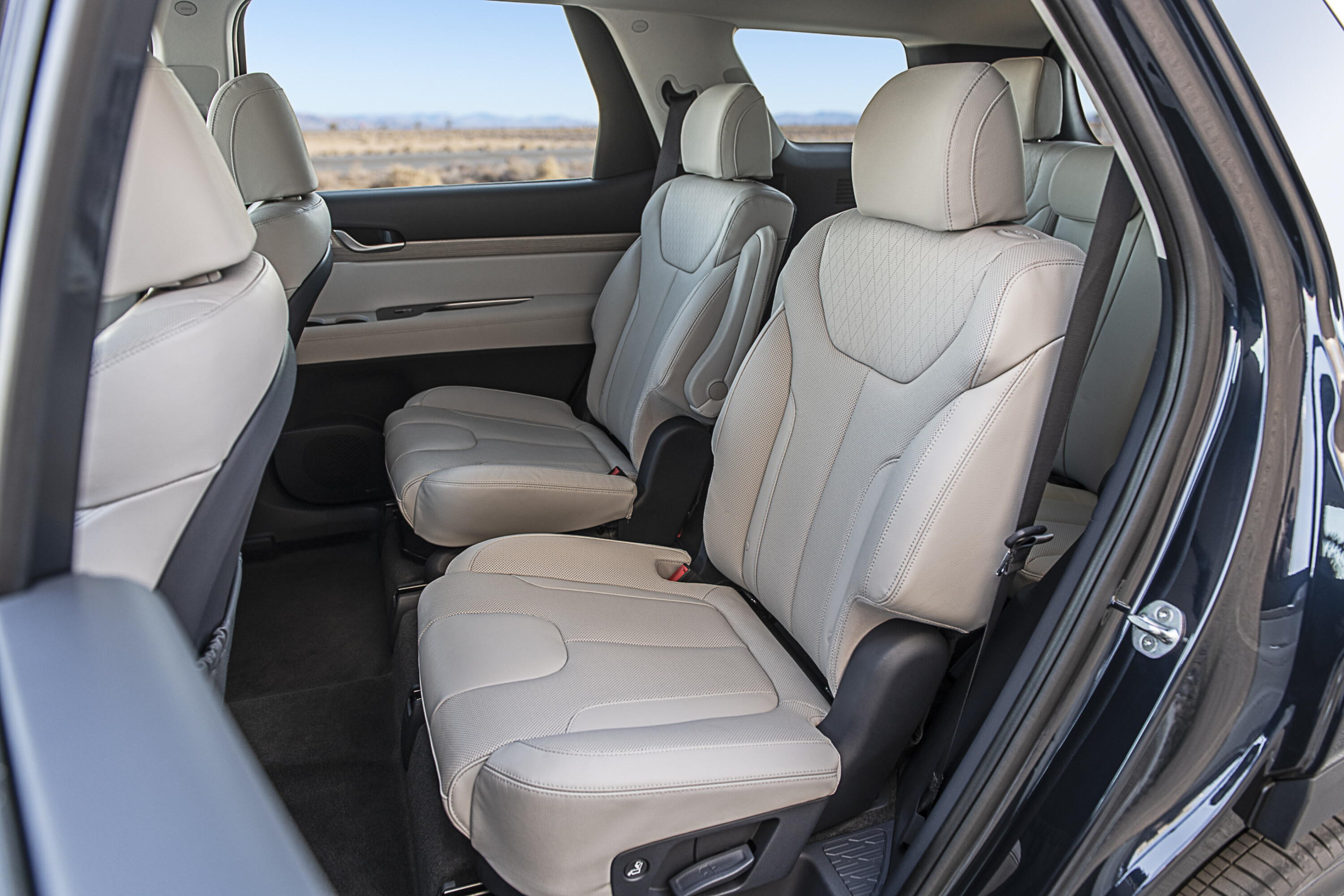
It’s also pretty easy getting back there (even without captain’s chairs)…
Starting things off is the Elite with 16 cup holders and seven USB charge points to its name, around 30 per cent of which can be found in the oft-forgotten third row (there are vents, too) which is spacious – even for six-foot adults. Three across the back would be a squeeze, but two are remarkably comfortable.
It’s also pretty easy getting back there (even without captain’s chairs) as the Palisade has an electronic button that releases both the backrest and the slider, and with the seat slid forward there’s plenty of room to step up into the rearmost seats.
The second row is extremely accommodating with heated outboard seats even in the ‘entry’ Elite. It’s also packed with quality materials backed by apparently excellent build quality. The Palisade’s rear bench can slide and the backrest tilt to balance cargo and passenger space as needed.
It features a glut of child-carrying options, too, with three top tether points in the second row and two in the third backed up by ISOFIX anchors (two for the second row and a single for the third).
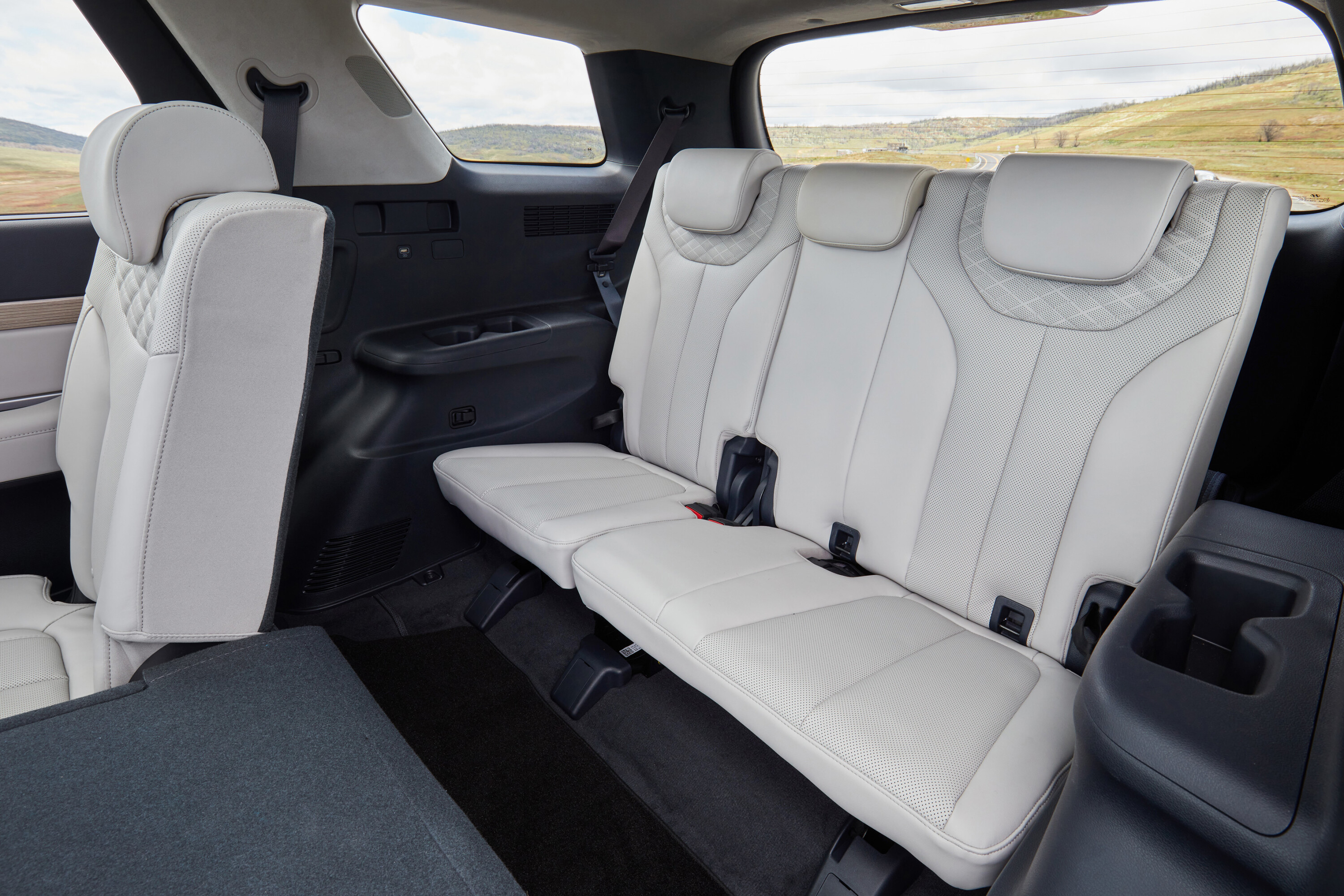
… it truly does feel ‘Range Rover-lite’
Amenities don’t stop in the middle with USB charge ports in the shells of the front seats to keep cables from dragging on the floor, plus a third climate zone with fan control. The Palisade Highlander adds integrated sun shades as well as quilted Nappa leather upholstery with ventilation for front and second-row seats – it truly does feel Range Rover-lite.
In the front, the seats are broad and supportive with good adjustment in either grade, while the leather-smothered dashboard and generous appliqué of soft-touch materials give an impression of premium in the Palisade that’s missing from the Toyota Kluger and Nissan Pathfinder.
Not that it’s a trade-off for practicality, as the centre console has a retractable lid under which you can hide the cup holder area and phone charging pad. A cavernous cubby beneath the centre armrest is great for storing valuables, while a capacious under-console tray easily accommodates a tissue box or handbag.
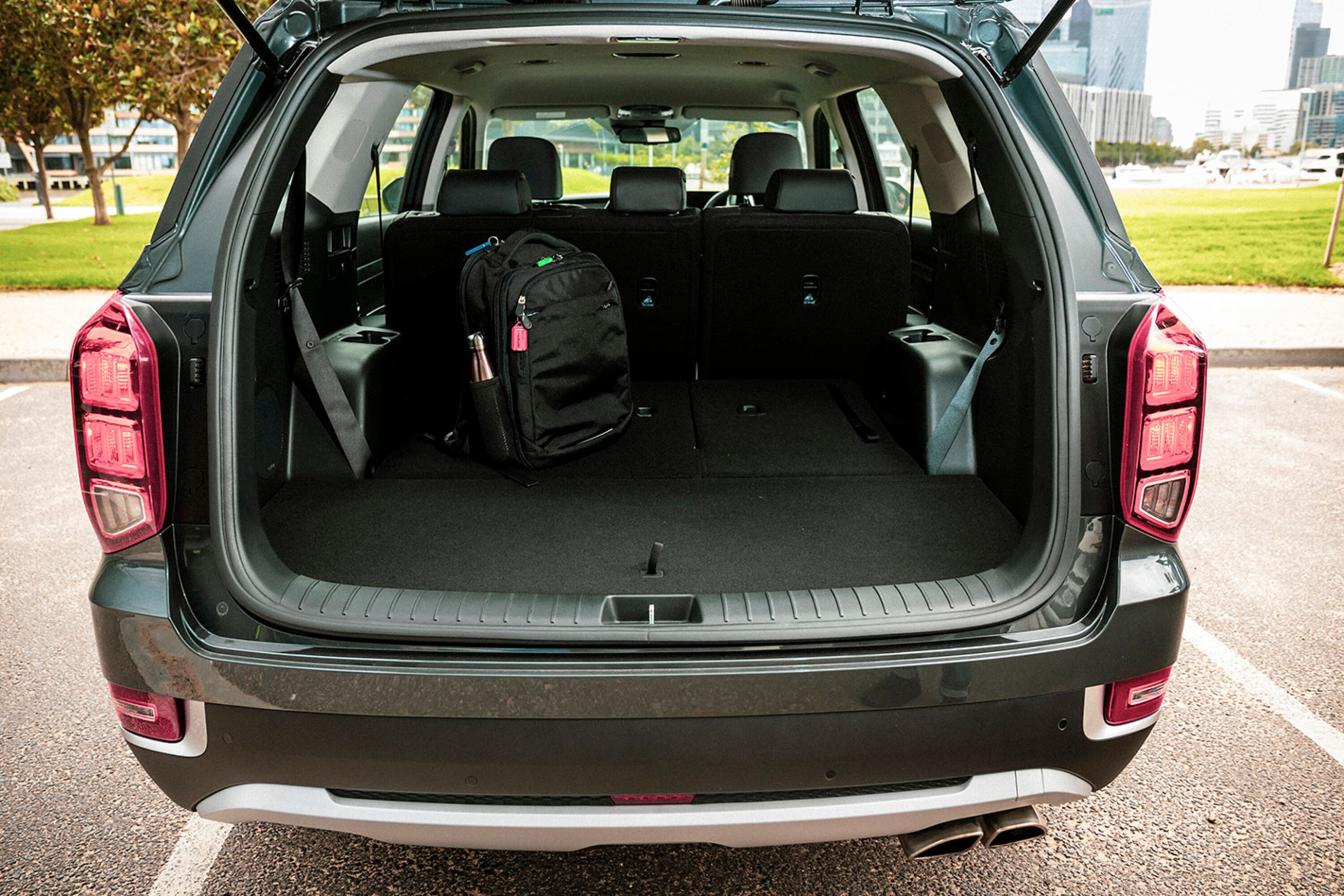
How much boot space does the Hyundai Palisade offer?
Unlike some rivals, the Hyundai Palisade retains a truly usable boot with three rows of seating in place, offering 311 litres (VDA) of capacity.
Stowing the third row brings that to 704 litres, but the Palisade’s boot has even more to give.
Beneath the floor is a storage compartment that houses the cargo blind and a rolled-up floor mat for when you have the third row stowed to minimise debris dropping through the gaps. There’s a light in the boot, as well as electronic buttons to fold the second row flat.
The Palisade’s full-size alloy spare wheel is slung beneath the vehicle and is relatively easy to access in the event of a puncture.
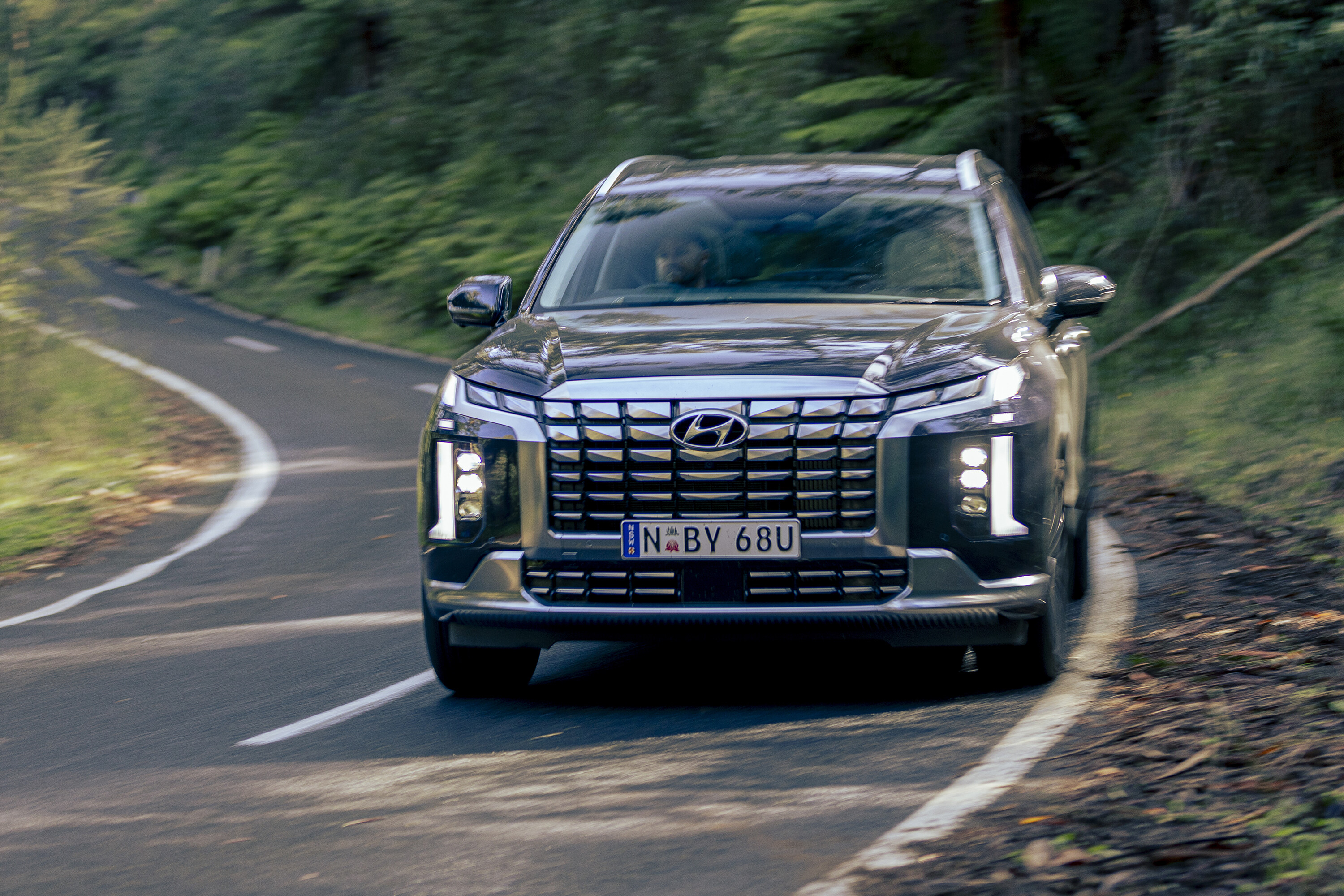
I like driving, will I enjoy this car?
Nothing in the Palisade’s class offers dynamic nirvana, but this sizeable SUV manages to blend decent road-holding with a very agreeable ride.
There are two engines in the Palisade, and the one we wholeheartedly recommend (and that the public is putting their money towards) is the turbo-diesel.
Although the 217kW/355Nm 3.8-litre direct-injected petrol V6 is a smooth and willing engine, it’s hamstrung by being front-wheel drive. In a vehicle that weighs between 1911-1984kg with soft suspension, wheelspin is a common occurrence in the wet. It’s also very thirsty, rated at 10.7L/100km ADR combined or a whopping 14.9L/100km on the urban ADR cycle.
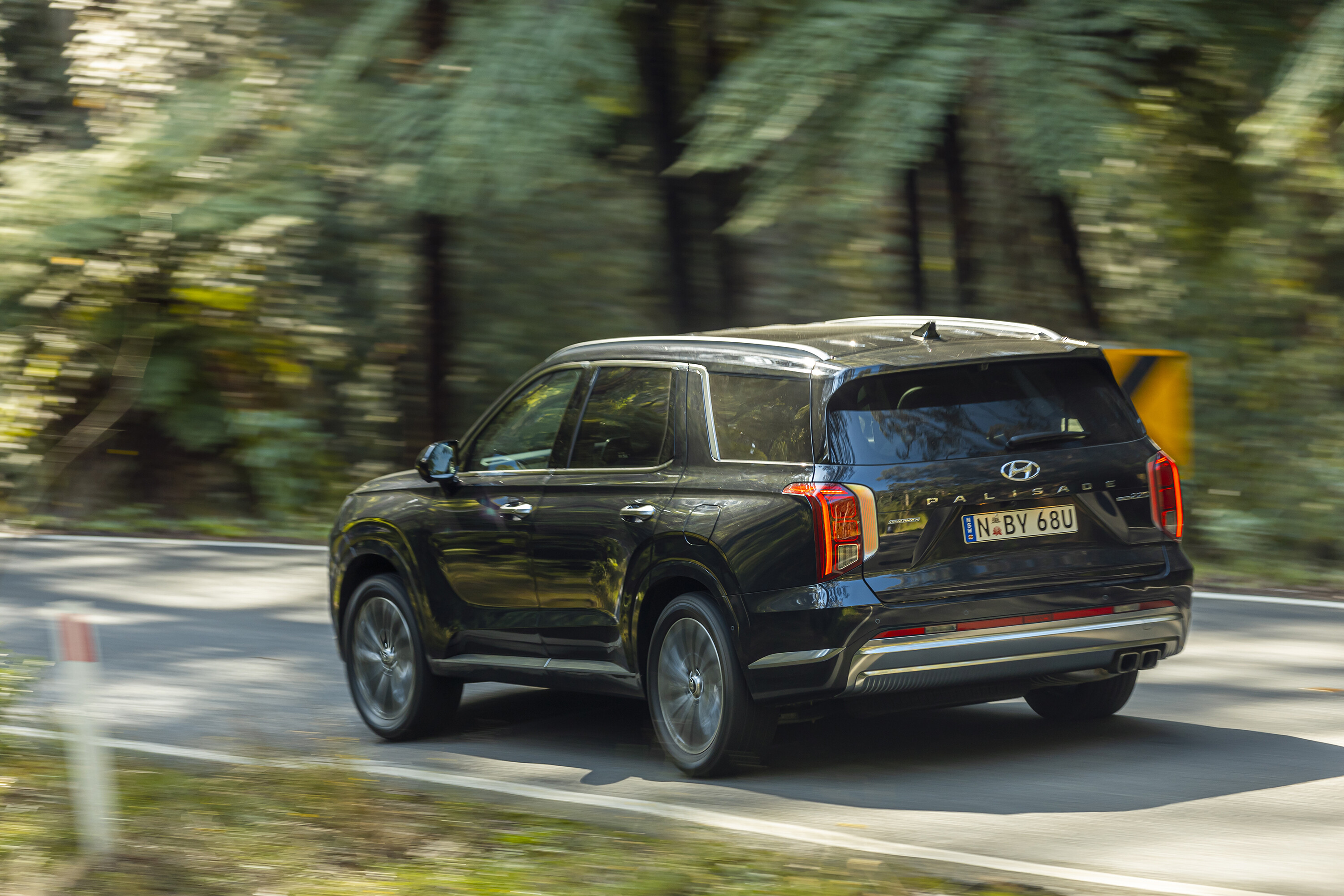
Oil burners may be out of vogue, but with no shadow of a doubt, the Palisade’s turbo-diesel is preferable to the thirstier V6 petrol.
And not least because diesel brings with it the security of all-wheel drive. With a 440Nm torque peak backed up by 147kW, the 2.2-litre iron block diesel feels a lot nippier and less stressed in the real world than the petrol.
The more expensive four-cylinder diesel does introduce some clatter at idle but, once on the move, it’s refined and well-behaved (for its type) with overall noise, vibration and harshness levels relatively low. Wind noise is impressively absent for such a brick, too. Paired with the Palisade diesel is an eight-speed automatic transmission that selects gears swiftly and decisively.
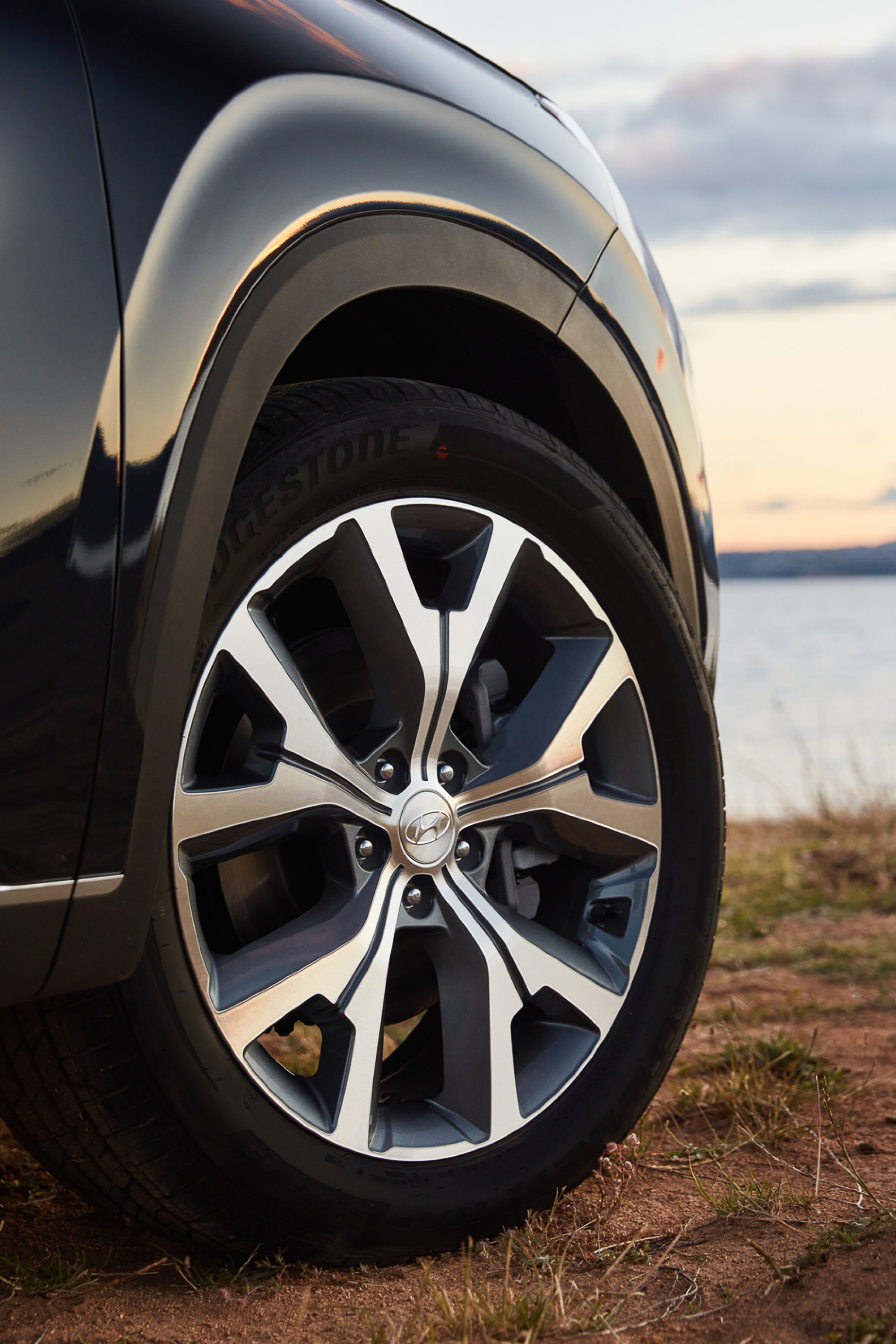
Changing through the eight drive modes (four on-road and three off-road) affects the gearbox logic; we’ve found Smart or Comfort to be the most natural for steering and powertrain calibration.
Sand, Snow and Mud modes also tweak the HTRAC all-wheel drive system’s torque bias, though without locking front or rear differentials the differences are negligible in practice.
The Palisade’s tough American looks may give the impression of a vehicle with marshmallows for springs, but its road manners translate enormously well to Australian roads. The only place the Palisade occasionally suffers is at low speed over small amplitude bumps where its large and heavy wheels amplify small shocks into the cabin.
Somewhat ironically, the Palisade is one of few Hyundais that hasn’t been subjected to local suspension tuning. Yet this big barge manages to be athletic and consistent enough to make confident progress on pockmarked backroads while retaining a level of plushness and isolation over Australia’s horrid country road surfaces.
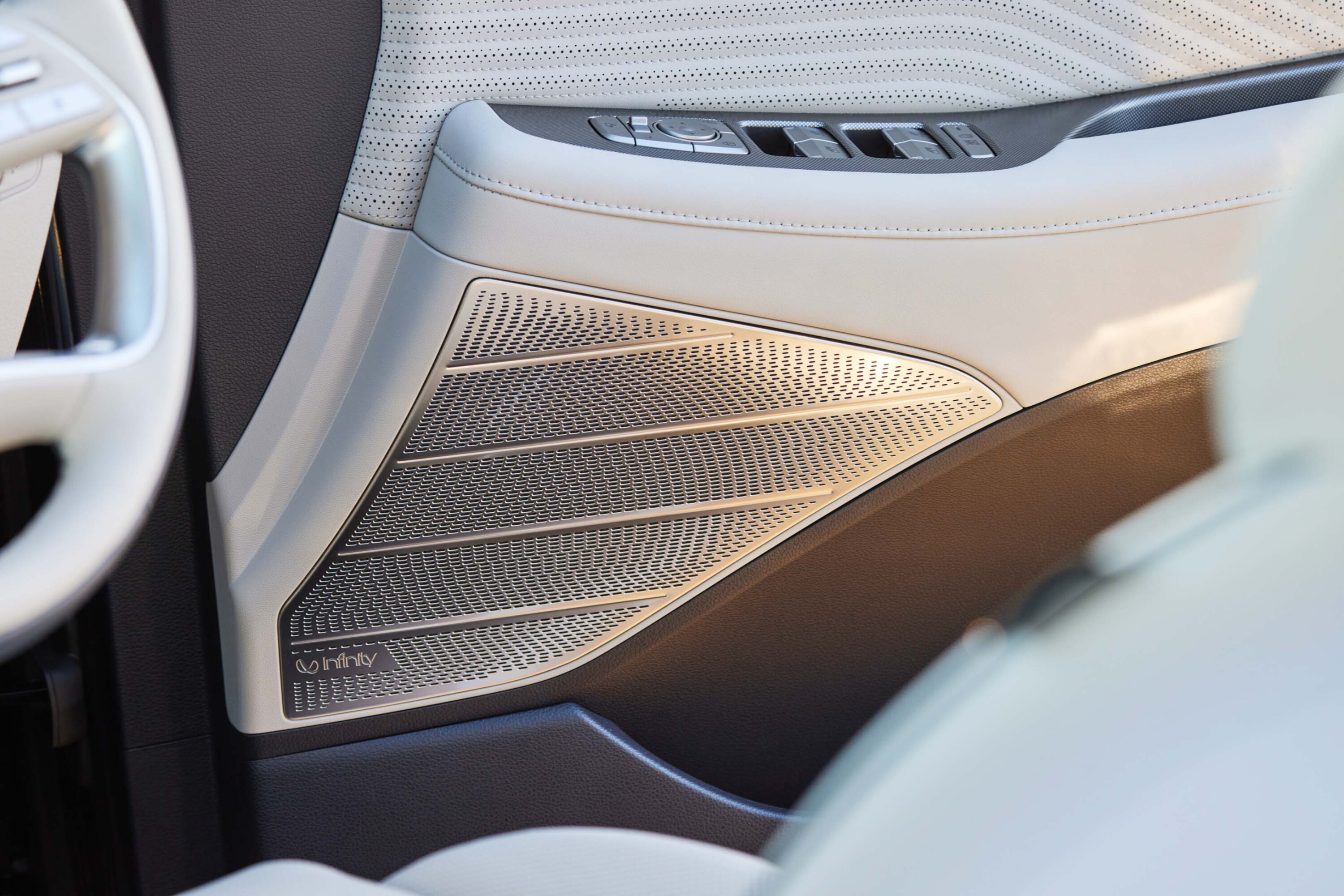
Hyundai’s new four-spoke steering wheel is hooked up to a light steering system that masks the Palisade’s considerable mass.
This is ideal in town and on motorways, where Palisades are likely to spend the bulk of their lives.
Forward visibility is decent over the Palisade’s tall bonnet, while rear and blind-spot visibility is aided by a 360-degree surround-view monitor and blind-spot cameras on the top-spec Highlander.
If any of the terms in this section have left you scratching your head, these articles will help bring you up to speed!

- What is a Powertrain or Drivetrain?
- Power vs torque
- Car suspension explained
- Automatic transmissions (‘gearboxes’) explained
- Chassis control systems explained
- Car vs Ute vs SUV: How the vehicle you buy should guide the way you drive
The Hyundai Palisade is a big, big SUV – and that’s reflected in its fuel use.
Opting for the 3.8-litre petrol V6 would see you using 10.7L/100km if you could replicate the ADR 81/02 combined consumption test – in reality, consumption is even higher in the suburbs.
As off-trend as diesel engines are, they make sense in this vehicle type. The Palisade diesel’s combined ADR figure is a more reasonable 7.3L/100km.
| 2023 Hyundai Palisade Powertrain | Claimed fuel economy (ADR 81/02) | CO2 emissions (combined) |
|---|---|---|
| 3.8-litre direct-injection petrol V6 | 10.7L/100km | 251g/km |
| 2.2-litre turbo-diesel four-cylinder | 7.3L/100km | 193g/km |
What is the Hyundai Palisade’s towing capacity?
The Hyundai Palisade is rated to tow a 2200kg braked load with either engine and unbraked towing capacity maxes out at 750kg.
Take care, however, as the Palisade’s maximum permitted tow ball weight is 100kg with the standard towing kit, and only the diesel is available with the heavier-duty 180kg tow ball set-up.
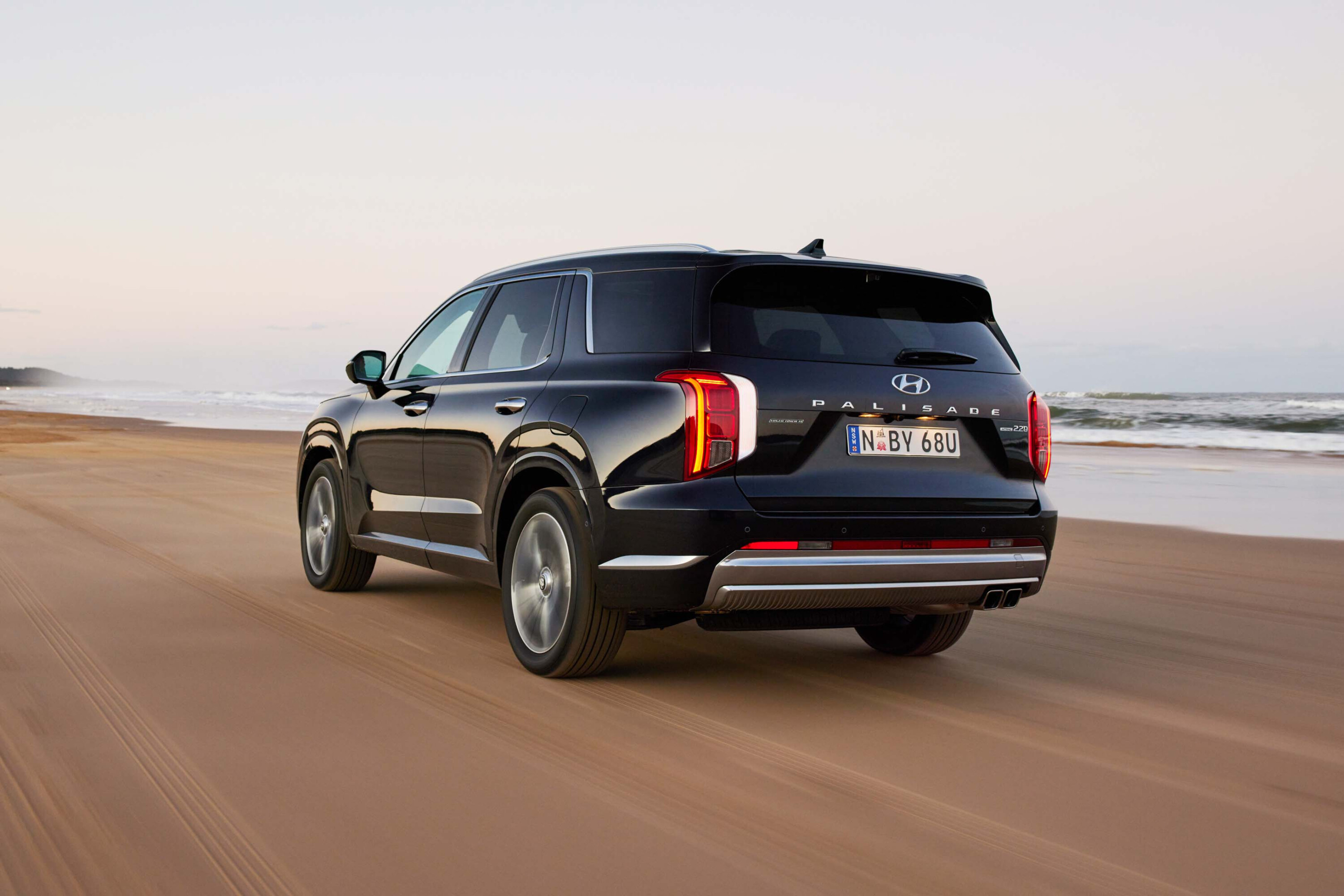
How long is the warranty and what are the Hyundai Palisade’s servicing costs?
The Hyundai Palisade is covered by a five-year / unlimited-kilometre warranty.
Palisade servicing is due annually or every 15,000km for either engine after an initial 1500km check-up. Over the first five years, each service is capped at $399 for the 3.8-litre petrol V6 or $489 for the 2.2-litre turbo-diesel.
Hyundai also offers the ability to pre-pay for servicing packages, though the cost is the same as pay-as-you-go. Five years/75,000km for the V6 costs $1995, and the diesel $2445.
Which version of the Hyundai Palisade does Wheels recommend?
Value is what it comes down to here. As Tony O’Kane put it, the fit-for-purpose Palisade “gives you an eight-course banquet with a three-course price tag”.
It comes down to which Palisade best fits your budget. We’d be inclined to spend the extra cash on the AWD diesel, rather than jumping to a Highlander Petrol. If you can stretch for the range-topping diesel, we say do it – there ain’t much under $80K that gets this closer to Range Rover chic than a Hyundai Palisade Highlander.
What are the Hyundai Palisade’s key rivals?
ud83dudd3c Back to topWhat might annoy me?
With the latest update, Hyundai introduced speed limit assist functionality that beeps when you exceed the posted limit.
Clever in theory, but it’s not smart enough to detect time-sensitive areas such as school zones – so if you drive through a school-hours 40km/h area on a Sunday afternoon, it will beep at you for travelling at the prevailing speed limit.
It wouldn’t be so annoying if you could disable the system for good (should you wish) but, for now, it takes several taps on the touchscreen every time you start the car.
A petrol AWD model would also be appreciated, but according to Hyundai, the V6 can’t be packaged with that in right-hand drive markets. The issue is solved for the smaller Santa Fe, which is available as an AWD petrol-electric hybrid.
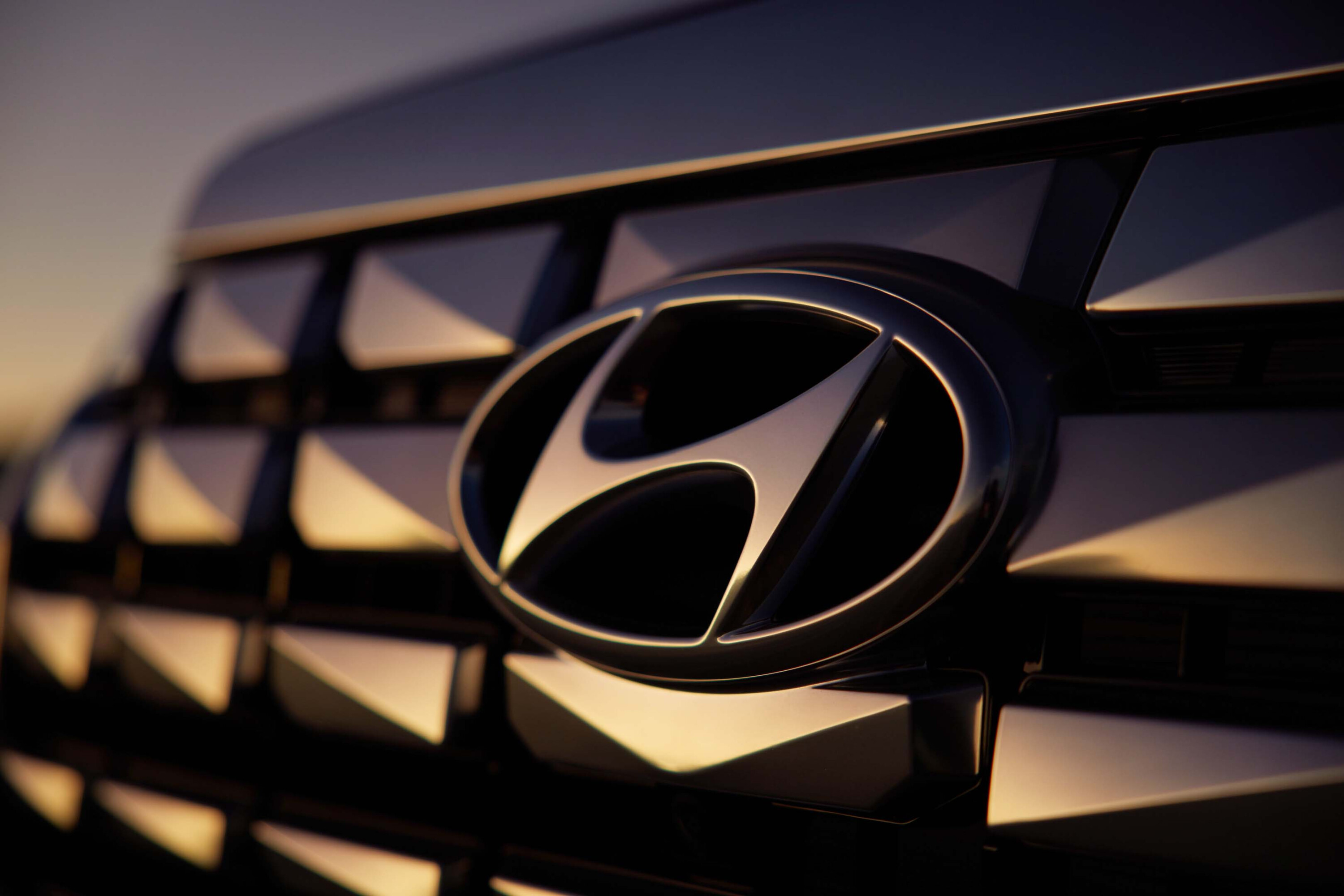
What’s the infotainment system like?
For 2023, the Hyundai Palisade’s list of technological features grew to include 12.3-inch displays – one responsive touchscreen for the infotainment, and a separate LCD housing the digital instrument panel.
The graphics are legible and navigating the menus is simple. A cable is still required for Apple CarPlay and Android Auto smartphone mirroring, but the connection is at least reliable. A wireless charging pad and faster USB-C charge points are now standard, too.
Adding to the tech suite is Hyundai’s BlueLink telematics system which, via a smartphone app, allows the control of basic functions such as tyre pressure monitoring, brake condition, remote starting (though it isn’t a fully digital key – you need the fob to drive off), door locking and window controls, with a find-my-car function and emergency SOS call button also present.
With the app, you can even set a destination using your phone and send it to the car’s navigation, while the phone app also integrates with Google Maps for ‘last mile’ navigation, providing final walking directions from a nearby car park, for example.
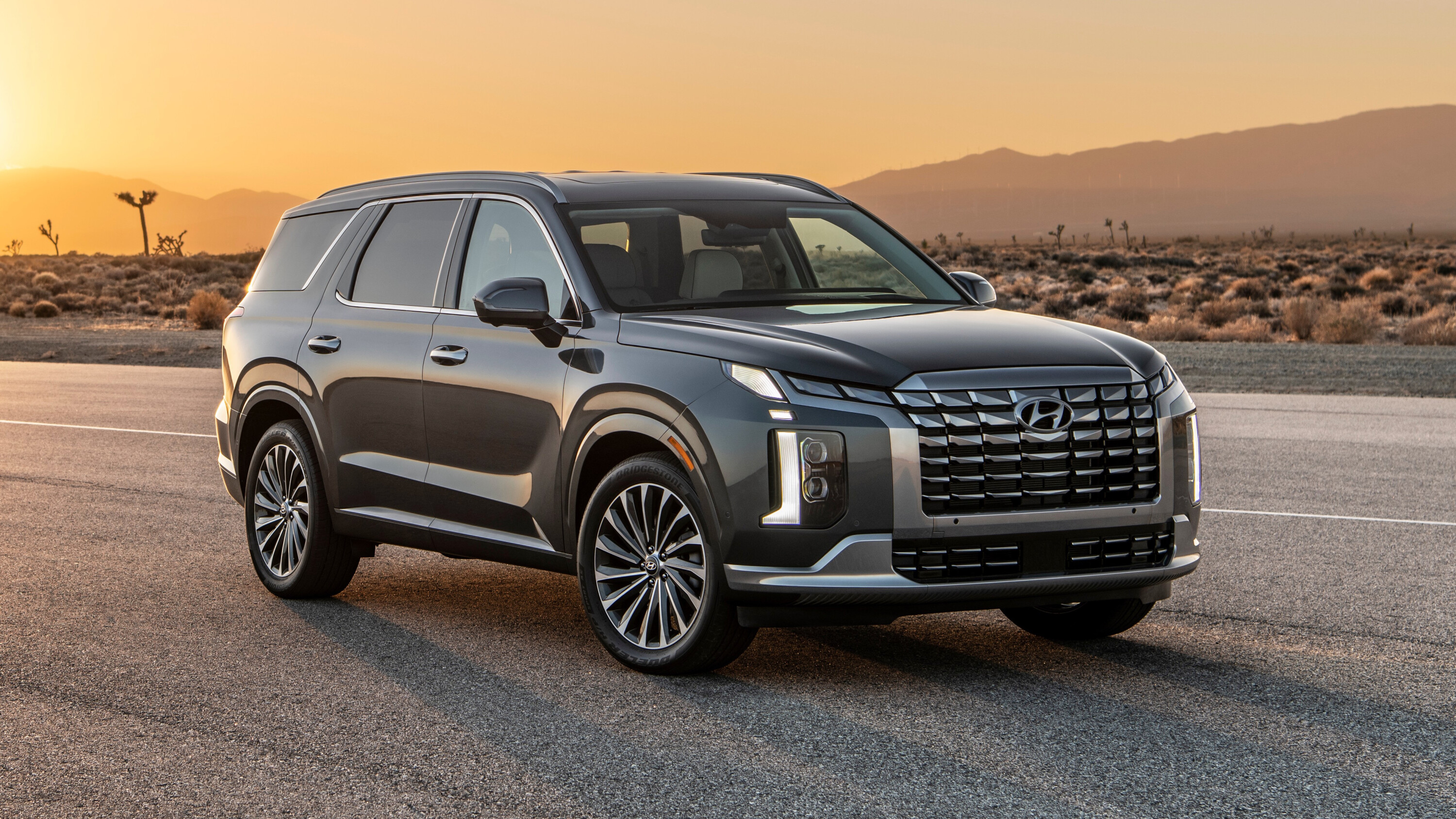
Where does Hyundai make the Palisade?
The right-hand drive Hyundai Palisade is manufactured for the Australian market in South Korea.
Are there plans to update the Hyundai Palisade soon?
The current model Hyundai Palisade was introduced in August 2022. Expect a new generation to be revealed in late 2024.
Hyundai has ruled out hybrid power for the existing Palisade, so we’ll have to wait for the next-gen car to get electrified drive.
Score breakdown
Things we like
- Clever packaging and thoughtful touches
- Comfortable ride with solid road-holding
- Plenty of features for the money
Not so much
- Thirsty petrol V6
- Nannying speed limit assist




